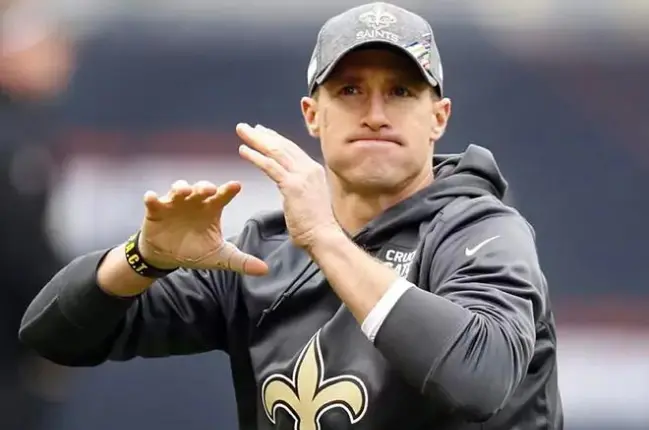In a surprising turn of events, retired NFL quarterback Drew Brees has revealed that he can only throw left-handed now. This unexpected revelation has sparked curiosity and raised questions about how such a significant shift in skill set could happen to a player known for his precision and prowess as a right-handed quarterback. Let’s delve into the details of Drew Brees’ journey, exploring the circumstances surrounding his transition to left-handed throws and the potential impact on his legacy.
The Revelation: A New Chapter Unfolds
Drew Brees, renowned for his illustrious career with the New Orleans Saints, recently disclosed that due to a series of injuries, he has undergone a transformation in his throwing abilities. Once known for his pinpoint accuracy with right-handed throws, Brees now finds himself adapting to a left-handed throwing style. This revelation has left fans, sports analysts, and the football community at large both astonished and intrigued.
The Toll of a Storied Career: Injuries and Adaptation
Brees’ journey from a Super Bowl-winning quarterback to a left-handed thrower is underscored by the toll that a lengthy and physically demanding NFL career can take on a player’s body. Throughout his tenure, Brees faced his fair share of injuries, with the latter part of his career marked by challenges such as shoulder issues and ligament damage in his throwing hand. The cumulative effect of these injuries has necessitated a radical adjustment in his throwing mechanics.
Adapting to Change: The Mental and Physical Challenge
Transitioning from right-handed to left-handed throws is not merely a physical adjustment but also a mental challenge. Brees, known for his meticulous preparation and strategic mindset, now faces the task of reprogramming his muscle memory, decision-making processes, and overall approach to the game. This adaptation speaks to his resilience and determination to stay connected to the sport he loves, even in the face of unexpected challenges.
Legacy and Impact: Redefining Expectations
Drew Brees’ unexpected shift to left-handed throws adds a new layer to his already storied legacy. While many retirees turn to commentary, coaching, or other off-field roles, Brees has chosen to redefine expectations by showcasing his adaptability and commitment to the game. This unconventional chapter in his post-retirement journey serves as an inspiration to athletes facing similar challenges and highlights the multifaceted nature of sports careers.
Fan and Community Response: A Mix of Surprise and Support
The revelation about Brees’ left-handed throws has elicited a spectrum of reactions from fans and the football community. While some express surprise and curiosity about the implications for his involvement in the sport, there is also a prevailing sense of support and admiration for Brees’ resilience. Fans who have followed his career closely are likely to continue doing so, eager to witness how this unexpected development unfolds.
The Evolving Role of Retired Athletes: Breaking Stereotypes
Drew Brees’ journey invites reflection on the evolving role of retired athletes in the modern sports landscape. Traditionally, retirement has been synonymous with stepping away from the field, but Brees’ story challenges this stereotype. By embracing a new skill set and showcasing his adaptability, he sets a precedent for retired athletes to continue contributing to the sports they love in unexpected and innovative ways.
Impact on Training and Development: Lessons for Aspiring Athletes
Brees’ transition to left-handed throws provides valuable lessons for aspiring athletes and those currently engaged in sports training and development. It underscores the importance of adaptability, mental fortitude, and a willingness to embrace change. In an era where sports science and training methodologies continually evolve, Brees’ journey serves as a reminder that athletes must be open to adjusting their approach to meet the demands of their bodies and the game.
Speculations About Future Involvement: Coaching, Mentoring, or More?
As Drew Brees navigates this new phase of his post-retirement journey, speculation abounds regarding his potential involvement in coaching, mentoring, or even a return to a more active role in the football community. Whether he chooses to impart his wealth of knowledge to the next generation of quarterbacks or takes on a different capacity within the sport remains to be seen. Regardless, the football world watches with keen interest as Brees’ story continues to unfold.
The Unpredictability of Athletic Journeys: A Lesson in Resilience
Drew Brees’ transition to left-handed throws serves as a poignant reminder of the unpredictability inherent in athletic journeys. No matter how meticulously a career is planned, unforeseen challenges can reshape its trajectory. Brees’ resilience in the face of adversity provides a blueprint for athletes grappling with unexpected twists in their own paths, illustrating that the journey is as much about adapting to change as it is about achieving success on the field.
Conclusion: Drew Brees’ Left-Handed Throws – A Chapter Yet to Be Written
As the football world grapples with the revelation of Drew Brees’ left-handed throws, one thing is certain – this is a chapter in his story that is yet to be fully written. Whether it leads to a new era of involvement in the sport, inspires a generation of athletes facing challenges, or simply stands as a testament to the unpredictable nature of athletic journeys, Brees’ left-handed throws have ignited a fresh conversation about resilience, adaptability, and the enduring love for the game. As the football community eagerly awaits the unfolding of this unexpected narrative, Drew Brees continues to leave an indelible mark on the sport he has dedicated his life to.


